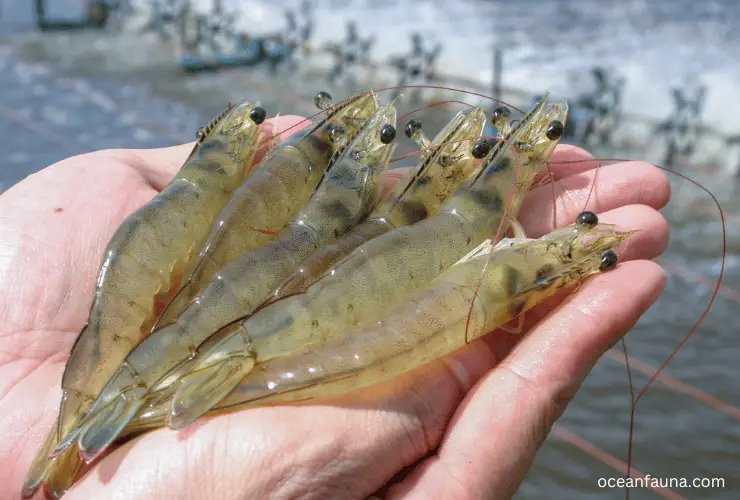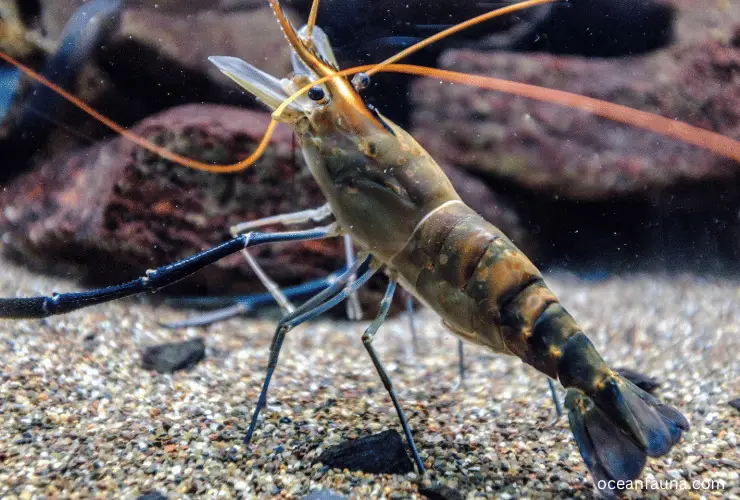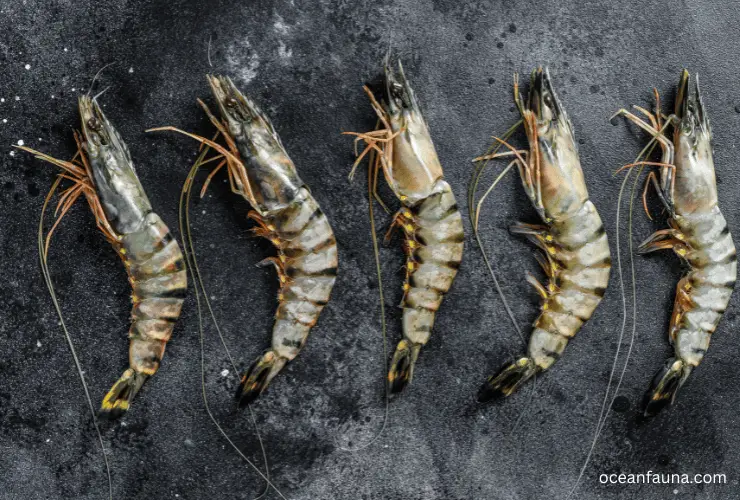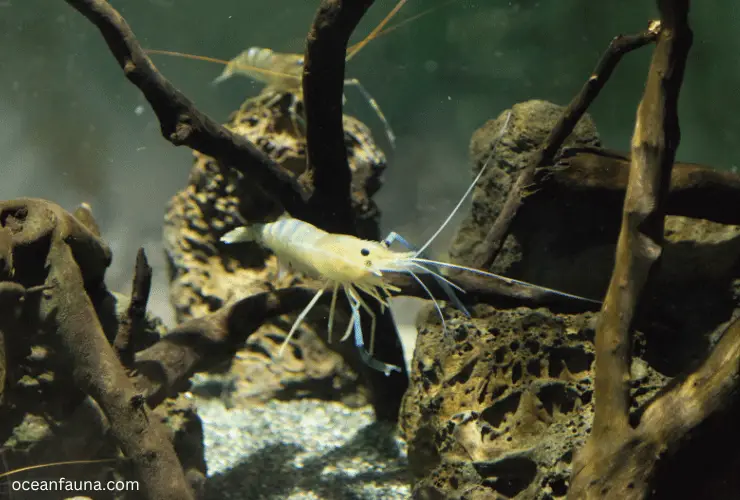Although shrimps consume organic matter, including decaying plants and animals, which aids in decomposition, they act more as scavengers than true decomposers.
So, are shrimp decomposers? My opinion is “No.” Scavengers and decomposers are not exact. And in this article, I will discuss their differences and why shrimps are not decomposers.
Are Shrimps Decomposers?
Shrimps are not considered true decomposers in the food web, despite their role in breaking down organic matter. While they do aid in decomposition by consuming decaying plants and animals, they function more as scavengers than decomposers.
True decomposers are organisms such as bacteria, fungi, and certain types of insects that break down organic matter into its basic nutrients, which are then recycled in the ecosystem.
Although shrimps can break down organic material into detritus, the bacteria ultimately reduce the detritus into nutrients. These nutrients, in turn, form an essential part of the food web, as other organisms use them to sustain life.

Although shrimps are not classified as true decomposers, they have a critical role in the ecosystem. They assist in preventing the accumulation of debris that could reduce oxygen levels and harm aquatic organisms by consuming decaying organic matter.
What Are the Differences Between Scavengers And Decomposers?
Both scavengers and decomposers are essential for maintaining the ecological balance by breaking down organic matter in the environment.
However, scavengers consume dead plants and animals directly, while decomposers consume the smaller particles that are left behind after scavengers have fed. All the differences are discussed below.
Definition and Function
Scavengers are animals that consume dead organisms or carrion to break down organic material into smaller particles. Their primary function is to remove dead organisms quickly to prevent the spread of disease and contamination.
Scavengers act as the first line of defense in cleaning up the environment, ensuring that organic matter does not build up and cause pollution.
Organisms known as decomposers are responsible for breaking down the particles produced by scavengers into essential nutrients that plants can absorb. Decomposers play a crucial role in recycling nutrients into the ecosystem by converting dead organic matter into usable nutrients.
Organisms Involved
Scavengers are mainly animals that include birds, crabs, shrimps, insects, and worms. These organisms have specialized features that enable them to feed on a wide range of carrion and dead organisms. For instance, some scavengers have sharp beaks to tear flesh, while others have strong jaws to crush bones.

Microorganisms like bacteria and fungi are examples of decomposers. Their main job is to break down organic matter by releasing enzymes that break down complex organic compounds into simpler ones.
Decomposition is also aided by invertebrates such as earthworms, millipedes, and snails that help break down organic matter into smaller particles.
Timeframe
Scavengers work quickly to remove dead organisms before they become breeding grounds for disease-causing agents. They act fast to reduce the risk of contamination and prevent the spread of diseases, making their actions very immediate and effective.
Decomposition, on the other hand, is a slow and continuous process that can take several years to complete. The speed of decomposition depends on several factors, such as temperature, humidity, and the nature of the organic matter. The decomposition rate also varies depending on the organisms involved.
Final Output

While scavengers break down the organic material into smaller particles, they do not convert the organic matter into nutrients suitable for other organisms. They play a vital role in cleaning up the environment and reducing the risk of contamination. However, they do not contribute to the nutrient cycle.
In contrast, decomposers further break down the smaller particles into essential nutrients released into the environment. These nutrients are then absorbed by plants, creating a vital link between dead organic matter and the living organisms in the ecosystem.
By breaking down the organic matter into nutrients, decomposers ensure that the nutrients are available to future generations of plants and animals.
Why Shrimps Are Not Decomposers?
Shrimps are not decomposers, and there are several reasons to support this claim. In this section, we will discuss these reasons in detail.
Lack of Chlorophyll
Like many other animals, shrimps do not possess chlorophyll – the green pigment that helps plants make their food through photosynthesis. Chlorophyll is essential for decomposers such as bacteria and fungi, which mainly feed on dead plants as well as other organic matter. Shrimps cannot be classified as decomposers without the ability to produce their food.
Method of Consumption
Shrimps consume organic matter through scavenging, meaning they feed on dead organisms directly. This is in contrast to decomposers like bacteria and fungi, which will only consume the smaller particles produced by scavengers.
As such, shrimps cannot be classified as decomposers since their method of consumption is different from true decomposers.
Feeding Habits
Shrimps mainly feed on plankton, algae, and other small organisms found in the water. This means they do not mainly feed on dead organic matter like decomposers. The lack of a specialized feeding habit makes it impossible to classify shrimps as decomposers.
Physical Characteristics
The physical characteristics of shrimps provide additional evidence that they are not decomposers. Shrimps have exoskeletons, meaning they have a hard outer covering that provides support and protection.
Decomposers such as bacteria and fungi lack this feature and have softer bodies that help them move freely in the soil or water.
Also, shrimps have highly developed sensory organs, such as antennae, which aid them in locating dead plant and animal material. Conversely, decomposers lack such complex sensory organs and rely on chemical signals to locate their food sources.
FAQs
Are shrimps consumers?
Yes, shrimps are undoubtedly consumers in the coral reef ecosystem. Shrimps feed on a variety of organisms, such as small fishes, plankton, and detritus. They are omnivorous in nature, which means they consume both plant and animal matter.
Shrimps play a vital role in the food chain, as they are a crucial link between primary producers (such as phytoplankton and algae) and higher-level consumers (such as larger fish, turtles, and humans).

Shrimps are also considered keystone species in the coral reef ecosystem, as they support the survival of other organisms. For example, they help to keep the reef clean by scavenging on dead organic matter, which can otherwise lead to an increase in harmful bacteria and parasites.
Additionally, shrimps provide food for various fish species and other predators, which are an integral part of the coral reef food web.
Recent studies have shown that shrimps have also evolved unique mechanisms to adapt to the changing environmental conditions in the coral reef ecosystem.
For example, some species of shrimps have developed the ability to filter out harmful contaminants and toxins from the water, which can help maintain the reef’s health and productivity.
Is shrimp a producer?
No, shrimp are not producers in the coral reef ecosystem. Producers, such as coral reefs, plankton, and algae, use energy from sunlight to produce their own food through photosynthesis. On the other hand, shrimps are consumers in the food chain as they feed on other organisms, such as plankton and algae.
Shrimps are classified as primary consumers as they are eaten by secondary consumers, such as small fish, which larger predators then eat. This type of consumption is known as a food chain and is essential for maintaining the balance of the coral reef ecosystem.
Only through the continuous supply of producers can the consumers at the top of the food chain, such as sharks, survive. Therefore, while shrimps are an important part of the coral reef ecosystem, they do not contribute to energy production and cannot be classified as producers.
What kind of consumer is shrimp?
Shrimp is an example of a versatile consumer that is capable of feeding on both phytoplankton and zooplankton, which are primary consumers. This makes it a primary and secondary consumer, depending on the food availability and consumption.
As a primary consumer, shrimp feeds on phytoplankton, which are small aquatic plants that use photosynthesis to produce food. These tiny organisms form the base of the aquatic food chain and provide essential nutrients and energy to the shrimp. In this sense, shrimp acts as a primary consumer since it feeds directly on the producers of the ecosystem.
However, shrimp can also act as a secondary consumer since it feeds on zooplankton, which are small aquatic animals that feed on phytoplankton. Zooplankton are primary consumers since they obtain nutrients and energy from consuming producers.
As such, when shrimp feeds on zooplankton, it is considered a secondary consumer since it obtains its nutrients and energy from another consumer in the food chain.
Conclusion
Now you know in detail that shrimps are not decomposers. These omnivorous crustaceans consume both living and dead matter, classifying them as scavengers. However, decomposers solely consume dead matter.
Shrimps differ from decomposers in that they break down small living or dead organisms into tiny particles, while decomposers consume small particles of decaying organic matter.
Furthermore, shrimps have physical features which differentiate them from true decomposers such as bacteria and fungi.
If you want to know more, let me know. I will answer them as soon as possible.

